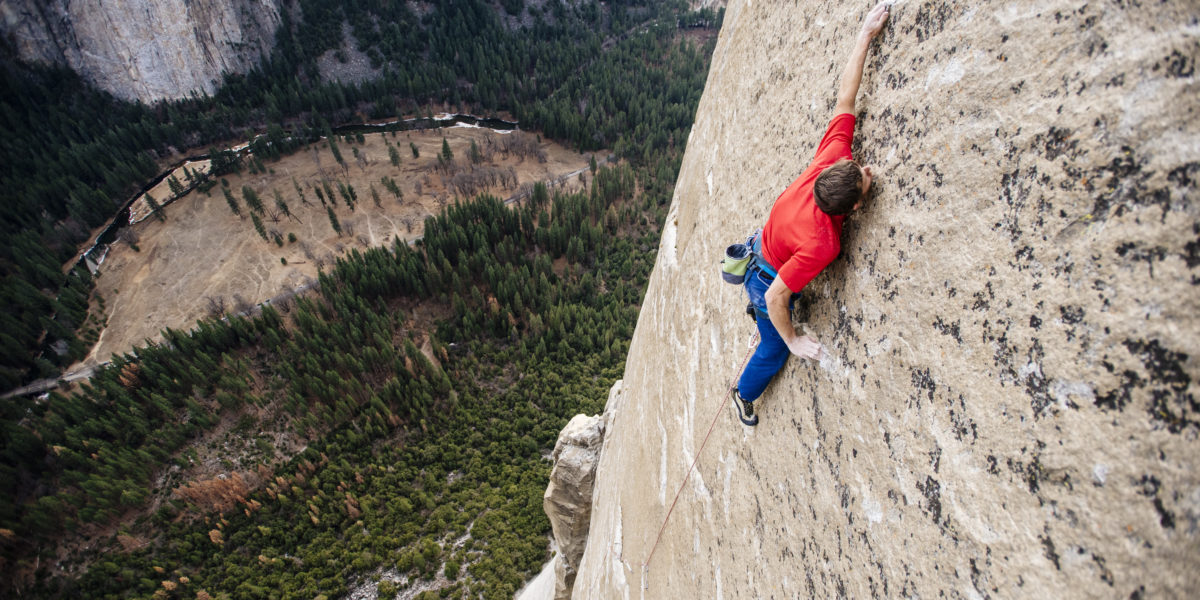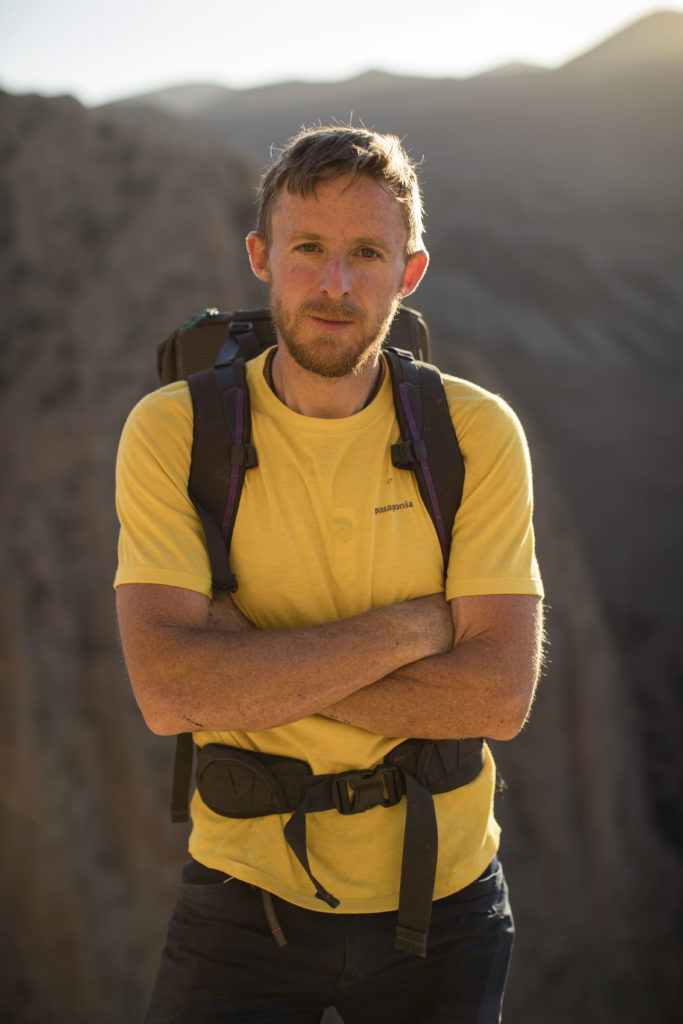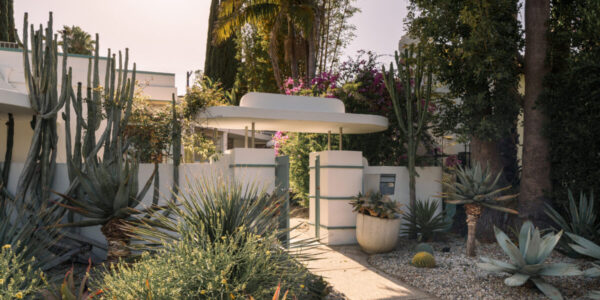
Tommy Caldwell Climbs Toward a Future of Climate Change Activism
The increased popularity of the outdoors industry is providing a platform to influence climate-related politics and policy-making.

Courtesy of Protect Our Winters

Few names conjure up images of herculean feats in the rock climbing world more than Colorado native Tommy Caldwell. And though he touts a résumé brimming with death-defying accomplishments—notably, the first-ever free climb of Yosemite National Park’s Dawn Wall route of El Capitan and subsequent 2017 film bearing the same name—it is Caldwell’s present endeavor that just might be his most meaningful yet.
Drawing from the added wisdom that oftentimes accompanies parenthood, the 43-year-old father of two joined a growing chorus of athletes and scientists comprising Protect Our Winters, an advocacy group founded in 2007 by big mountain snowboarder Jeremy Jones to bring education and innovation to the outdoor community’s efforts to stifle the detriments of climate change.
Caldwell recently spoke with Sunset about his blossoming role in POW, how historic droughts and signs of a rapidly warming planet seen by those who make a living in high mountain altitudes catalyzed an eagerness to help, and what he hopes to accomplish with his newfound platform.
You’ve spent your life in the outdoors. At what point did your perspective shift from general appreciation to wanting to take action to protect these places?
At some point, with age, you go from simply wanting to experience as much as you can to wanting to give back. Being an ambassador for Patagonia, I’ve been pretty influenced by the work they and their founder Yvon Chouinard do. They have such a robust storytelling platform, whether it be [covering] endangered species or climate, and when you’re in that fold all the time you start to understand the significance.
I spend so much time in Yosemite and Rocky Mountain National Park, and seeing these places burned down during historic fires, seeing droughts, seeing trees dying—it’s happening everywhere and it makes you want to act. After The Dawn Wall I realized I’ve got a little bit of a megaphone with this platform, so I might as well try and do some good with it.
How has the evolution of certain environments impacted the climbing community specifically?
I never used to climb in Yosemite in November, but now it’s almost ideal. October used to be the target timeframe, so it’s shifted by a month. That’s alarming. I think three out of the last five seasons I had to leave Yosemite early because of smoke in the valley. Everything becomes inaccessible.
And that’s just the fire side of the discussion. I’ve totally stopped going to Patagonia, which is one of my favorite places in the world to climb. Those mountains that have historically been frozen together and solid are now being exposed to these high-pressure systems that thaw them out. It seems like somebody dies during every good weather window because of the resulting rock fall. So, as a dad, it just doesn’t seem responsible anymore for me to go. As climbers, we probably see these symptoms of climate change a little more acutely than others, and having that understanding is all the more reason to do something.

Courtesy of Protect Our Winters
Climbing has grown substantially in recent decades, both in appreciation and participation. Have you been surprised by the influence your platform now holds?
That’s one of those things that has continually surprised me. I got into climbing not because it was a way to gain influence or to be a part of a movement or anything like that. I just loved climbing.
But that change has been drastic. So many people are climbing, and I never would have thought that popularity, or the popularity of the outdoors industry, would have any sort of influence in politics and policy-making. But organizations like Protect Our Winters and Patagonia are showing that you can harness it to do good.
Your steps toward advocacy included getting involved with Protect Our Winters. How has working alongside climate scientists and other athletes like Jeremy Jones informed what you’re trying to accomplish?
Protect Our Winters is pretty hard-hitting, and one of the most impactful things they do is bring scientists together with athletes in a collaboration that’s really a one-two punch. We might understand how it’s going from a symptomatic standpoint—what we see when we’re out in the mountains—but then you add the science to that and it really starts to create a vivid picture.
As a climber, it’s easy to notice it getting warmer. Maybe the seasons get pushed back or things close because of forest fires. But as a snowboarder [like Jones], you’re looking at the prospect of there not even being snow in California in the future. Losing an entire sport and a massive economic driver for these areas is significant.
Your involvement with POW sometimes entails lobbying politicians about climate initiatives. How does bringing a non-traditional background—climbers, winter sports athletes—to the table help facilitate discussions?
I think it’s more exciting. If you’re a politician, you’re used to people trying to influence you from all angles—the traditional lobbyists in a suit who spout numbers. But what’s really powerful is being able to tell good stories, and outdoor enthusiasts live those stories. Climbing or skiing are fun things to discuss, so there’s a different level of receptiveness there.
The outdoors brings some authenticity into politics, which can be a good reprieve from the norm. So much in Washington is run by young staffers and so many of them are outdoor enthusiasts, so it helps appealing to the people pulling the levers. Politics are definitely messy and it’s easy to hate that that’s how change gets accomplished, but we’ve just got to do the best we can with it. If we can use our voices and community to make positive change, we should do it.
What advice would you give someone looking to get more involved in the climate fight, whether it be with POW or any organization positioned to make a difference?
Surround yourself with a community of people who are motivated to get it done so you can be inspired to do so. Join organizations like POW or pick a few big organizations to follow their storytelling, donate, and get involved.
One thing that’s super key is to find local environmental nonprofits in your area and get to know those people. Go out on volunteer projects and be surrounded by people who want to make a difference close to home. Patagonia has this amazing platform called Action Works where you can type in your ZIP code and it’ll pull up all the environmental nonprofits in your area as well as links and instructions on how to get involved.
And then, of course, vote. Learn the issues—that’s another thing Protect Our Winters does through their POW Action Fund. It offers a great guide for everyone to get to know climate issues so you can be so much more informed when you vote in elections—and that’s on national and local levels. It all makes a difference.
What’s on your agenda in terms of your own advocacy plans?
I really want to find ways to share adventurous stories that overlap with climate change in the most engaging way. I went on an incredible trip recently to the Arctic National Wildlife Refuge, where we were able to analyze climate change and speak with local Indigenous populations to gauge that impact. Those places are rapidly changing and we really need impassioned people to get involved.
The Indigenous viewpoint is so important. We need to talk to them, hear their stories and understand how their lives are changing. I’ve recently been working with organizations in Bears Ears [National Monument]. Just getting to know these people … they could be our greatest teachers. They understand these beautiful places. They know how to treat them, whereas we, in our history as Western colonists, have viewed these areas as a resource to extract and make money. We need to change that.
Ultimately, I want to share stories that expand our knowledge of what we’re seeing. Climbers, in some ways, are like the eyes and ears of the mountains, the hard-to-get-to places, the poles and high-altitude regions where you see the acute effects of it all a bit more. That puts us in a position to highlight these messages and stories that can impassion people to do the right thing, and we should try and run with that.
